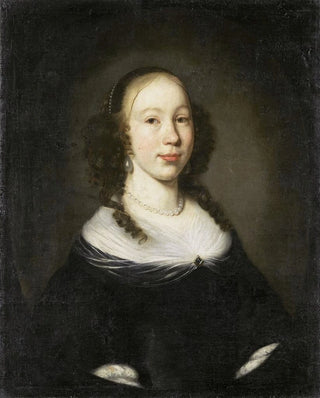Art print | Portrait of a young woman - Nicolaes Maes


View from behind

Frame (optional)
Captivating Introduction
The "Portrait of a Young Woman" by Nicolaes Maes is a work that embodies the quintessence of 17th-century Dutch portraiture. Through this painting, the artist manages to capture not only the physical appearance of his model but also a psychological depth that invites the viewer to reflect on the life and thoughts of this young woman. The soft light filtering through the drapes of her clothing and her contemplative gaze testify to an exceptional craftsmanship, making this work a true masterpiece of Baroque painting. Contemplating this art print transports us to a world where time seems suspended, where every detail matters, and where emotion is revealed at every glance.
Style and uniqueness of the work
Maes's style is distinguished by his meticulous attention to detail and his masterful use of light. In this portrait, the young woman is depicted with a delicacy that highlights the finesse of her features and the richness of her clothing. The nuances of colors, ranging from warm tones to cooler shades, create a harmonious balance that draws the eye. The artist employs chiaroscuro techniques to accentuate the relief of her face, thus adding an almost sculptural dimension to her portrait. Every element, from the fold of the fabric to the sparkle of jewelry, is carefully considered to enrich the visual storytelling, making this painting not only a representation but also a true story to discover. The intimacy of the captured moment, where the young woman appears lost in her thoughts, gives the work an atmosphere of mystery and poetry.
The artist and his influence
Nicolaes Maes, born in Dordrecht in 1634, is a Dutch painter who established himself in the art world thanks to his exceptional talent and his ability to capture the human essence. A pupil of Rembrandt, he assimilated his master's techniques while developing a unique style characterized by a singular sensitivity. Maes evolved over the years, shifting from genre painting to more intimate portraits, where emotion and psychology of the characters take a prominent place. His influence is felt not only

Matte finish

View from behind

Frame (optional)
Captivating Introduction
The "Portrait of a Young Woman" by Nicolaes Maes is a work that embodies the quintessence of 17th-century Dutch portraiture. Through this painting, the artist manages to capture not only the physical appearance of his model but also a psychological depth that invites the viewer to reflect on the life and thoughts of this young woman. The soft light filtering through the drapes of her clothing and her contemplative gaze testify to an exceptional craftsmanship, making this work a true masterpiece of Baroque painting. Contemplating this art print transports us to a world where time seems suspended, where every detail matters, and where emotion is revealed at every glance.
Style and uniqueness of the work
Maes's style is distinguished by his meticulous attention to detail and his masterful use of light. In this portrait, the young woman is depicted with a delicacy that highlights the finesse of her features and the richness of her clothing. The nuances of colors, ranging from warm tones to cooler shades, create a harmonious balance that draws the eye. The artist employs chiaroscuro techniques to accentuate the relief of her face, thus adding an almost sculptural dimension to her portrait. Every element, from the fold of the fabric to the sparkle of jewelry, is carefully considered to enrich the visual storytelling, making this painting not only a representation but also a true story to discover. The intimacy of the captured moment, where the young woman appears lost in her thoughts, gives the work an atmosphere of mystery and poetry.
The artist and his influence
Nicolaes Maes, born in Dordrecht in 1634, is a Dutch painter who established himself in the art world thanks to his exceptional talent and his ability to capture the human essence. A pupil of Rembrandt, he assimilated his master's techniques while developing a unique style characterized by a singular sensitivity. Maes evolved over the years, shifting from genre painting to more intimate portraits, where emotion and psychology of the characters take a prominent place. His influence is felt not only






